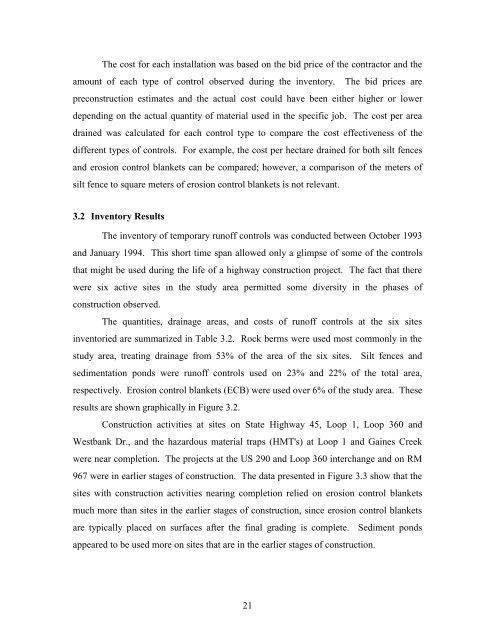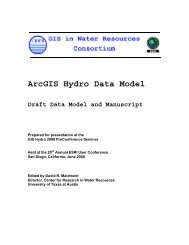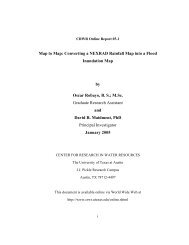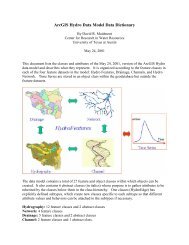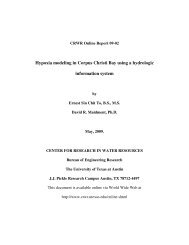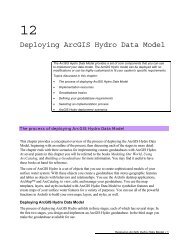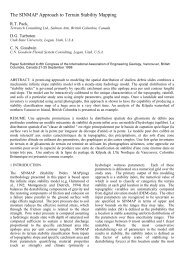View the Whole Report - Center for Research in Water Resources ...
View the Whole Report - Center for Research in Water Resources ...
View the Whole Report - Center for Research in Water Resources ...
You also want an ePaper? Increase the reach of your titles
YUMPU automatically turns print PDFs into web optimized ePapers that Google loves.
The cost <strong>for</strong> each <strong>in</strong>stallation was based on <strong>the</strong> bid price of <strong>the</strong> contractor and <strong>the</strong><br />
amount of each type of control observed dur<strong>in</strong>g <strong>the</strong> <strong>in</strong>ventory. The bid prices are<br />
preconstruction estimates and <strong>the</strong> actual cost could have been ei<strong>the</strong>r higher or lower<br />
depend<strong>in</strong>g on <strong>the</strong> actual quantity of material used <strong>in</strong> <strong>the</strong> specific job. The cost per area<br />
dra<strong>in</strong>ed was calculated <strong>for</strong> each control type to compare <strong>the</strong> cost effectiveness of <strong>the</strong><br />
different types of controls. For example, <strong>the</strong> cost per hectare dra<strong>in</strong>ed <strong>for</strong> both silt fences<br />
and erosion control blankets can be compared; however, a comparison of <strong>the</strong> meters of<br />
silt fence to square meters of erosion control blankets is not relevant.<br />
3.2 Inventory Results<br />
The <strong>in</strong>ventory of temporary runoff controls was conducted between October 1993<br />
and January 1994. This short time span allowed only a glimpse of some of <strong>the</strong> controls<br />
that might be used dur<strong>in</strong>g <strong>the</strong> life of a highway construction project. The fact that <strong>the</strong>re<br />
were six active sites <strong>in</strong> <strong>the</strong> study area permitted some diversity <strong>in</strong> <strong>the</strong> phases of<br />
construction observed.<br />
The quantities, dra<strong>in</strong>age areas, and costs of runoff controls at <strong>the</strong> six sites<br />
<strong>in</strong>ventoried are summarized <strong>in</strong> Table 3.2. Rock berms were used most commonly <strong>in</strong> <strong>the</strong><br />
study area, treat<strong>in</strong>g dra<strong>in</strong>age from 53% of <strong>the</strong> area of <strong>the</strong> six sites. Silt fences and<br />
sedimentation ponds were runoff controls used on 23% and 22% of <strong>the</strong> total area,<br />
respectively. Erosion control blankets (ECB) were used over 6% of <strong>the</strong> study area. These<br />
results are shown graphically <strong>in</strong> Figure 3.2.<br />
Construction activities at sites on State Highway 45, Loop 1, Loop 360 and<br />
Westbank Dr., and <strong>the</strong> hazardous material traps (HMT's) at Loop 1 and Ga<strong>in</strong>es Creek<br />
were near completion. The projects at <strong>the</strong> US 290 and Loop 360 <strong>in</strong>terchange and on RM<br />
967 were <strong>in</strong> earlier stages of construction. The data presented <strong>in</strong> Figure 3.3 show that <strong>the</strong><br />
sites with construction activities near<strong>in</strong>g completion relied on erosion control blankets<br />
much more than sites <strong>in</strong> <strong>the</strong> earlier stages of construction, s<strong>in</strong>ce erosion control blankets<br />
are typically placed on surfaces after <strong>the</strong> f<strong>in</strong>al grad<strong>in</strong>g is complete. Sediment ponds<br />
appeared to be used more on sites that are <strong>in</strong> <strong>the</strong> earlier stages of construction.<br />
21


